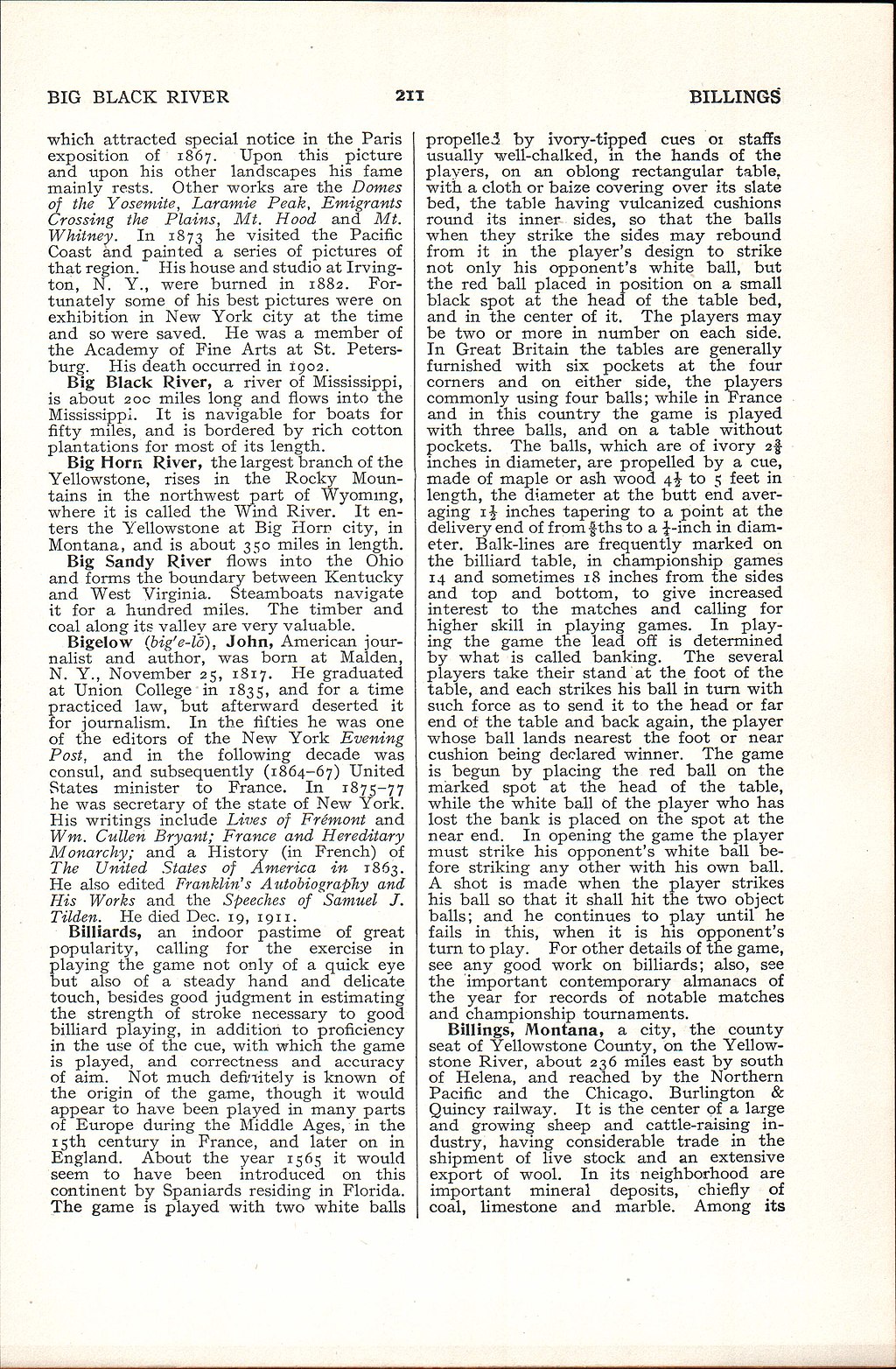BIG BLACK RIVER
211
BILLINGS
which attracted special notice in the Paris exposition of 1867. Upon this picture and upon his other landscapes his fame mainly rests. Other works are the Domes of the Yosemite, Laramie Peak, Emigrants Crossing the Plains, Mt. Hood and Mt. Whitney. In 1873 he visited the Pacific Coast and painted a series of pictures of that region. His house and studio at Irving-ton, N. Y., were burned in 1882. Fortunately some of his best pictures were on exhibition in New York city at the time and so were saved. He was a member of the Academy of Fine Arts at St. Petersburg. His death occurred in ±902.
Big Black River, a river of Mississippi, is about 200 miles long and flows into the Mississippi. It is navigable for boats for fifty miles, and is bordered by rich cotton plantations for most of its length.
Big Horn River, the largest branch of the Yellowstone, rises in the Rocky Mountains in the northwest part of Wyoming, where it is called the Wind River. It enters the Yellowstone at Big Horn city, in Montana, and is about 350 miles in length.
Big Sandy River flows into the Ohio and forms the boundary between Kentucky and West Virginia. Steamboats navigate it for a hundred miles. The timber and coal along its valley are very valuable.
Bigelow (big'e-lo), John, American journalist and author, was born at Maiden, N. Y., November 25, 1817. He graduated at Union College in 1835, and for a time practiced law, but afterward deserted it for journalism. In the fifties he was one of the editors of the New York Evening Post, and in the following decade was consul, and subsequently (1864-67) United States minister to France. In 1875-77 he was secretary of the state of New York. His writings include Lives of Fremont and Wm. Cullen Bryant; France and Hereditary Monarchy; and a History (in French) of The United States of America in 1863. He also edited Franklin1 s Autobiography and His Works and the Speeches of Samuel J. Tilden. He died Dec. 19, 1911.
Billiards, an indoor pastime of great popularity, calling for the exercise in playing the game not only of a quick eye but also of a steady hand and delicate touch, besides good judgment in estimating the strength of stroke necessary to good billiard playing, in addition to proficiency in the use of the cue, with which the game is played, and correctness and accuracy of aim. Not much defi'iitely is known of the origin of the game, though it would appear to have been played in many parts of Europe during the Middle Ages, in the 15th century in France, and later on in England. About the year 1565 it would seem to have been introduced on this continent by Spaniards residing in Florida. The game is played with two white balls
propelled by ivory-tipped cues 01 staffs usually well-chalked, in the hands of the players, on an oblong rectangular table, with a cloth or baize covering over its slate bed, the table having vulcanized cushions round its inner sides, so that the balls when they strike the sides may rebound from it in the player's design to strike not only his opponent's white ball, but the red ball placed in position on a small black spot at the head of the table bed, and in the center of it. The players may be two or more in number on each side. In Great Britain the tables are generally furnished with six pockets at the four corners and on either side, the players commonly using four balls; while in France and in this country the game is played with three balls, and on a table without pockets. The balls, which are of ivory 2$-inches in diameter, are propelled by a cue, made of maple or ash wood 4^ to 5 feet in length, the diameter at the butt end averaging if inches tapering to a point at the delivery end of fromf ths to a J-inch in diameter. Balk-lines are frequently marked on the billiard table, in championship games 14 and sometimes 18 inches from the sides and top and bottom, to give increased interest to the matches and calling for higher skill in playing games. In playing the game the lead off is determined by what is called banking. The several players take their stand at the foot of the table, and each strikes his ball in turn with stich force as to send it to the head or far end of the table and back again, the player whose ball lands nearest the foot or near cushion being declared winner. The game is begun by placing the red ball on the marked spot at the head of the table, while the white ball of the player who has lost the bank is placed on the spot at the near end. In opening the game the player must strike his opponent's white ball before striking any other with his own ball. A shot is made when the player strikes his ball so that it shall hit the two object balls; and he continues to play until he fails in this, when it is his opponent's turn to play. For other details of the game, see any good work on billiards; also, see the important contemporary almanacs of the year for records of notable matches and championship tournaments.
Billings, Montana, a city, the county seat of Yellowstone County, on the Yellowstone River, about 236 miles east by south of Helena, and reached by the Northern Pacific and the Chicago. Burlington & Quincy railway. It is the center of a large and growing sheep and cattle-raising industry, having considerable trade in the shipment of live stock and an extensive export of wool. In its neighborhood are important mineral deposits, chiefly of coal, limestone and marble. Among its
